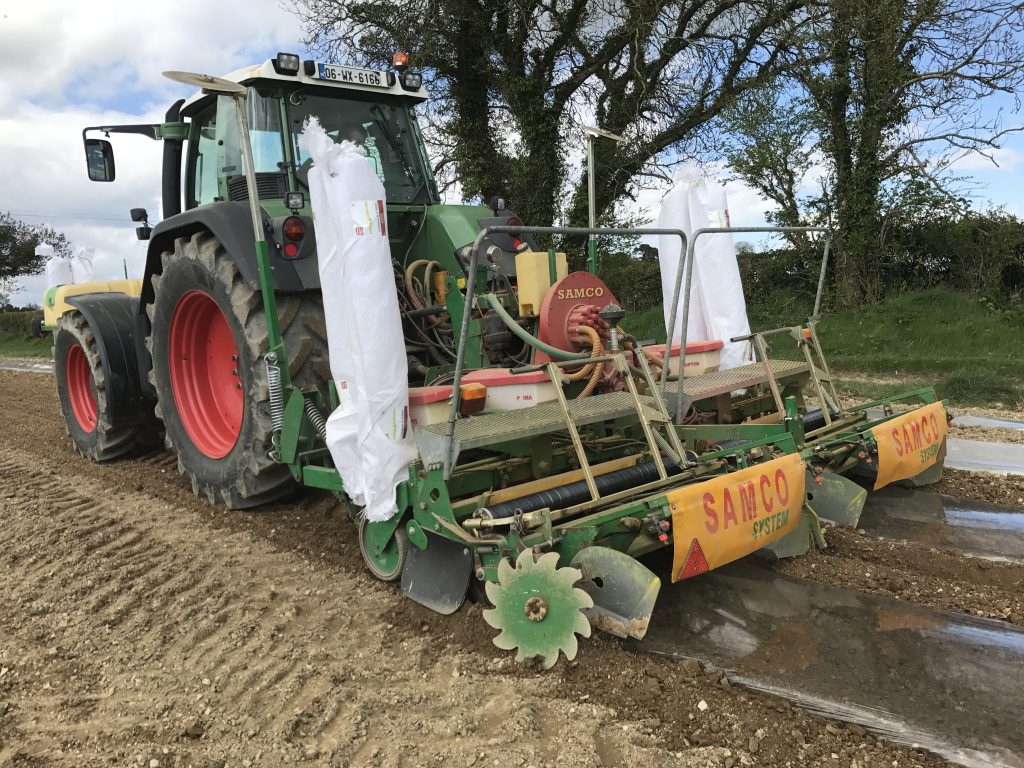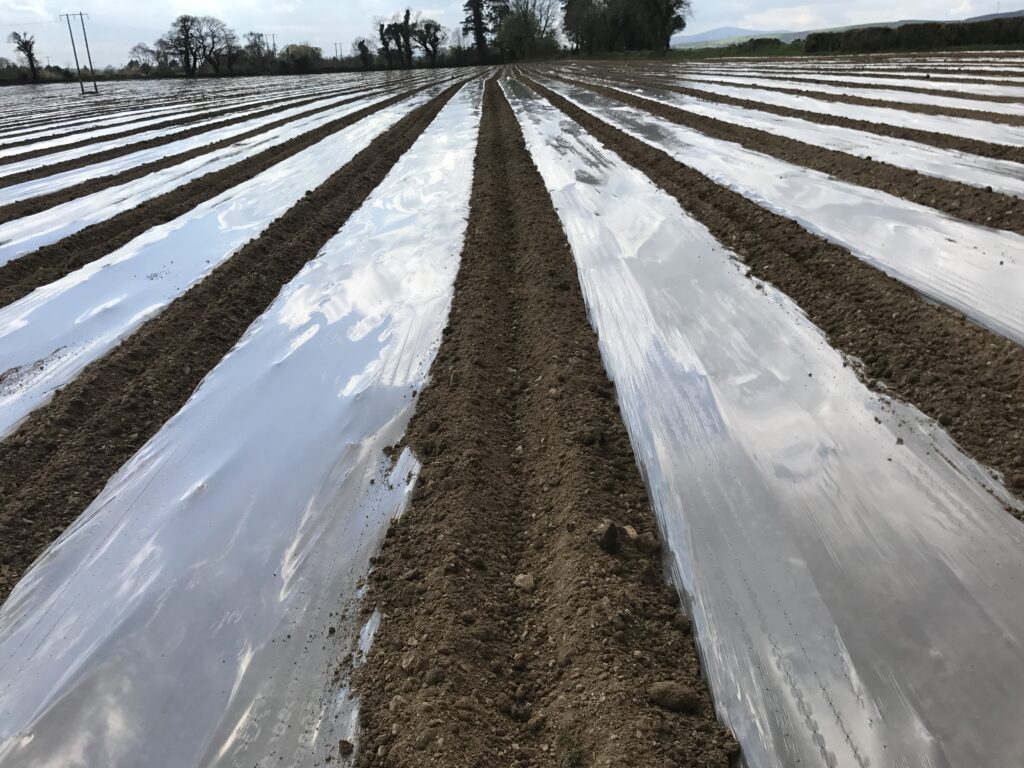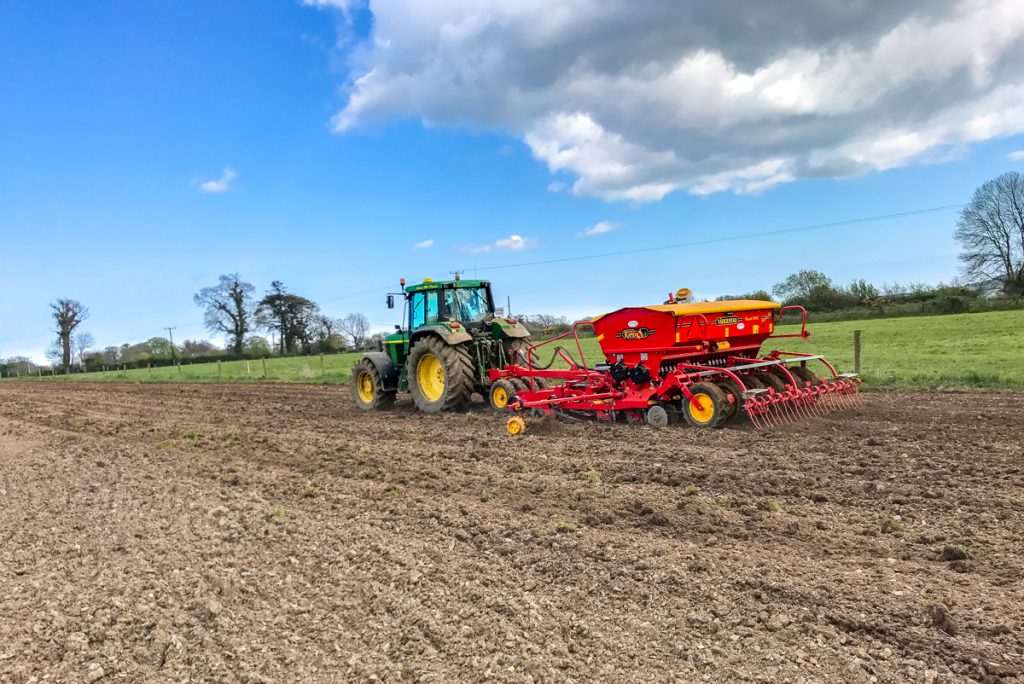Kevin McCann was finally getting into spring sowing when AgriLand visited his farm just outside Camolin in Co. Wexford this week. Maize was being planted in one field, while Kevin was sowing spring barley in the next.
It was the second day he had sown spring crops on his farm this spring. Up to this, conditions hadn’t allowed.
The maize is being grown on contract for two neighbouring dairy farmers. He’s been doing this for the past three years and it has opened up a lot of opportunities on his farm.
“The maize is all grown on contract. It’s not really on full contract; the farmers involved are looking for land and I’m looking for a break crop and for slurry, so it suits both parties. This is my third year growing it for one customer and I took on a new customer this year as well.
“It’s going to two spring-calving dairy herds. They’re using the maize more for buffer feeding in the summer time, when grass is scarce. The cows are on a certain amount of it in the winter, but it’s mainly a buffer for the summer,” Kevin explained.
While someone comes in to sow and harvest the maize, Kevin does the tillage work. The farmers taking the maize crop often spread their own slurry on the maize ground as well.
Kevin did admit that he knows the farmers involved very well and the fact that they are so nearby makes the agreement easier. They have a short draw to the pit at harvest time and a short draw to the field for slurry.
Cash flow
Kevin explained how growing maize under contract has taken away some of the volatility from his farm business.
The price being paid is set at the start of the season and the terms of the agreement are written down. He’s then paid throughout the year. He stressed the importance of setting a price at the start of the season, as the quality and yield of maize can vary hugely.
One of the reasons that Kevin doesn’t grow the maize on full contract is because there is no weighbridge nearby.
He stressed that farmers shouldn’t just be thinking of reaching a high price for the maize crop, as there are so many advantages to be gained from growing it. These include: the slurry; the break crop; and being able to sow niche crops afterwards.
“Lots of different agreements can be reached. You can do as much or as little of the machinery work that you like yourself.
“I know what I’ve made from this crop already. I do the work on the land and get paid for that; I pay the contractor that comes in to sow and harvest the crop; and I’m paid a price for my land.
“Payments can be set up monthly or bi-monthly. That’s a big help as regards cash flow on the farm because I’d be waiting until September for income from spring barley it that wasn’t there.
The first year I grew maize, I saw the difference in cash flow.
Kevin has farmed for 11 years. He enjoys the work, but the volatility of the market makes it difficult. He’s working to reduce the volatility on his farm and growing maize on contract has helped with this.
“It’s OK when you’re getting rewarded; but when you’re working long hours and working hard all year and you get €130/t for green barley, it’s not very rewarding.
“However, I do like it. I had two really good years, but last year was the fourth bad year in a row.”
Benefits in the rotation
The break crop is not only helping Kevin from a rotation point of view, but it has also allowed him to sow higher-value crops.
“It’s working really well in the rotation. I’m using it as a break crop and I can sow something different in my rotation after the crop of maize.
I have a crop of seed wheat gone in after last year’s maize. If it passes for seed, it will be worth €80-90/ac more, as well as the benefit of having slurry.
“I’m delighted to take the slurry and the farmer involved is delighted to have a short draw on his extra slurry. He supplies his own slurry to the field.”
- The seedbed prepared ahead of the maize sower
- Although it was a windy day sowing, the plastic was staying down
- One of the fields of maize being sown on Kevin’s farm
Under plastic
Kevin was sowing a few different varieties on the day, including: P8200; Justina; and P8201. He’s trialing the latter variety for Maizetech, where he gets all his maize inputs and advice. All of the maize is sown under plastic.
“For the three years I’ve had it, it has been grown under plastic. My father grew maize here a good few years ago in the open and one year we had a great crop and the next it wasn’t. The plastic is an insurance policy with maize really.”
So far, all of the maize has been harvested in good conditions.
“We’ve had no problems at all thankfully. It’s on good ground. We have lower-lying ground down the road, but we’ve always had the maize on the higher ground. So far it has been good,” Kevin added.
Spring barley
Kevin was sowing spring barley in ideal conditions on Tuesday (May 1). He had sown some barley on the previous day on his own farm and also sowed spring barley for hire on April 19. The opportunities for sowing have been limited.
The variety in the drill was Hacker. Kevin also has malting barley (Olympus) for Boortmalt and roasting barley (Planet) for Gardiner Grain in Gorey.
“We got a lot of rain when friends of mine in the midlands were sowing. We got more rain than a lot of places I think and a good bit of snow.
“It’s in good order. I pulled a press behind the plough. The Vaderstad needs the ground fairly level, so I ring rolled it as well,” Kevin explained.
New drill
Kevin bought a Vaderstad seed and fertiliser drill this season and put it to work for the first time this week. Kevin’s phosphorus (P) and potassium (K) levels are good on the farm.
The drill saves time and it has also opened up his hire work to farmers who want to use a combined drill.
“It’s great now. That’s my second seed and fertiliser drill. It’s easy to pull and I’m saving diesel. I’m also saving a pass because the fertiliser is going out in the drill.
Ps and Ks are good on the farm. The drill is only really to get over ground quicker. It’s solely a saving. It’s far easier to pull it.
Kevin has just invested in an automatic steering system (AutoTrac) on his farm and was using it on his sower when AgriLand visited.
“I only have it in since March. I’ve done a lot of spraying with it and it has worked perfect on the sprayer.
“It has the potential to make big savings on inputs – seed and fertiliser. It will do a lot of field recording; you can record inputs and get the weather and everything on it.”
Beet
Kevin has no pit to put maize into and grows beet for his parents, Terry and Eilis, who have beef animals.
“Beet makes up an important part of our finishing diets and in the diets of our autumn-calving suckler cows.
It won’t be sowed until next week. I want to get all of the spring barley in first.
“I use a contractor to spray the beet. I spray cereal crops for hire, so I don’t want to chance mixing anything else in the tank.
“I do a bit of hire work – tillage, sowing and spraying. I’m going to a new customer tomorrow who wants the seed and fertiliser to go down together.”
Three-crop rule
Kevin grows winter wheat; winter seed wheat; spring and winter barley; maize; and beet. He would normally have oats as well, but the year didn’t allow for the crop to be grown on his farm.
Kevin didn’t avail of the three-crop rule derogation.
“I was right enough. I had winter crops in, but I had ground ploughed for 25ac of winter barley and it rained every time I tried to get into the field.”
Kevin thought that the change to the rule, while needed in many parts of the country, was slightly unfair on people who sowed crops to meet the requirements.
“It wasn’t fair on farmers who were trying to do it right. They were bursting themselves to sow crops – like oats – when they weren’t going to get a huge return from them. So many people persevered with their beans and other people brought seed back,” he concluded.








